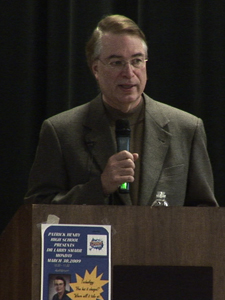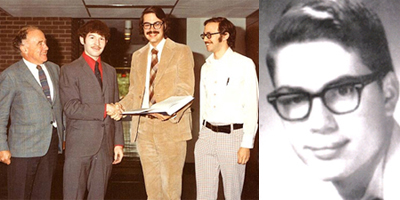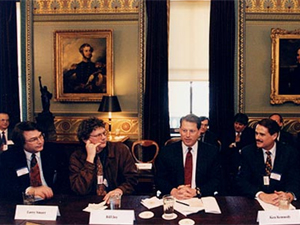Calit2 Director Smarr Shares Life of Science with High School Students at Nifty Fifty Presentation
By Tiffany Fox, (858) 246-0353, tfox@ucsd.edu
San Diego, Calif., April 3, 2009 — Something caused quite a stir in the auditorium at San Diego's Patrick Henry High School (PHHS) Monday, and it had nothing to do with the upcoming Prom festivities.
|
Larry Smarr, director of the California Institute for Telecommunications and Information Technology (Calit2) at the University of California, San Diego, was looking deep into the future, making predictions about what the next few decades might have in store for the 200-plus students assembled for his Nifty Fifty presentation.
"By the time you own a home," he predicted, "You'll be able to buy multi-million pixel-wallpaper and have your friends over to your house virtually, thanks to an optical fiber connection to your home. It will be a little bit beyond instant messaging," he said with a chuckle.
It was enough to send a wave of gasps and excited whispering through the auditorium, the locale for Smarr's hour-long Nifty Fifty talk on his life and career as a renowned astrophysicist and computer scientist. The San Diego Science Festival's Nifty Fifty program is an effort to bring middle and high school students in contact with local scientists. Although the program was initially designed to incorporate 50 presentations, more than 150 scientists signed up to speak at schools from Oceanside to San Ysidro.
|
The first-ever San Diego Science Festival — the biggest celebration of science on the West Coast — began February 28 and concludes tomorrow, April 4, with Expo Day in Balboa Park. Roughly 250 exhibits (including Calit2's) and related activities will take place both indoors and outdoors at the Expo from 10:30 a.m. to 6 p.m.
Calit2 will be setting up a CalMesh wireless mesh network to cover most of the exhibit areas, many of which have no Wi-Fi or only spotty access to the Internet. Researchers will also be using the network to test some of the wireless technologies developed for emergency response.
The organizers of the Festival estimate that it will positively impact more than 100,000 students throughout the greater San Diego area. From the science of earthquakes to the physics of skateboarding, the Festival and its associated Nifty Fifty presentations make science accessible, interactive and fun, highlighting the impact of science and innovation on our lives.
"I wanted to be a part of Nifty Fifty because it's fairly unusual for high school students to see a living, breathing scientist in their school," Smarr said. "I think it's really critical to the future of our country that we get a larger number of students into the science and engineering fields, and if I convinced 10 percent of the students here to think about science as a career, then I made a difference."
|
Smarr told the story of his life as a scientist through anecdotes and pictures, including a photo of him as a child playing with a Lionel model train and later shots of him (resplendent in a thick beard and corduroy jacket) taken during his time as director for the National Center for Supercomputing Applications (NCSA) at the University of Illinois at Urbana-Champaign, beginning in 1985.
"Students see all of these pictures of Einstein with gray hair," Smarr pointed out, "when in reality he made all his breakthroughs when he was a young man. I thought maybe if I shared what I looked like as a young, budding scientist, they might have a better idea of what it's really like to work your way up in the field."
Smarr also shared stories about his early research into how to use supercomputers to solve Einstein's equations of general relativity, which required him to secure a top-secret nuclear weapons clearance (the only supercomputers available in the U.S. at the time were in Department of Energy weapons labs). This led him to create his 1983 unsolicited proposal to NSF to create what became the NSF supercomputer centers.
He then described his current work with Calit2's Optiportal and integrating it with remote videoconferencing capabilities, enabling high-tech collaborations with NASA's new Lunar Science Institute. He also showed how the HiPerSpace tiled displays — with third of a billion pixels — have been used during the local wildfires.
|
Smarr also emphasized the importance of public service, as demonstrated by a photo of him in the White House with then-Vice President Al Gore during his participation on the President's Information Technology Advisory Committee (PITAC).
But if there was one thing Smarr wanted to instill in the students at PHHS, it was an understanding of just how profoundly the burgeoning climate crisis will affect them and the generations to come.
"This will be the defining issue for the rest of your lives," Smarr told the students. "Adapting to climate change will be the largest peacetime project in the history of humanity," he said citing author Thomas L. Friedman's prediction in his book, "Hot, Flat and Crowded." Smarr said if there is one book the students read this year, it should be this one.
During a Q&A session following Smarr's talk, several students asked about the future of "virtual sports," the energy-saving benefits of methane fuel and the potential for the technologies Smarr described to help solve some of humanity's greatest problems. At least one student sacrificed part of the valuable lunch hour to stick around after Smarr's presentation and ask for a little personal guidance.
|
When asked what she thought of Smarr's Nifty Fifty talk, freshman Sarah DuBose didn't hesitate.
"It was extremely interesting," she enthused, adding that her father enjoys sharing his passion for astrophysics with her. She said Smarr's talk, which also covered his research into black holes, inspired her "to look into UCSD and maybe join some of the programs there."
"I think the knowledge of the speaker was unmatchable," added Eric Wittgrove, a sophomore at PHHS. "I gained much more interest in the field of science just by listening to him."
For more photos from Larry Smar''s life and career, check out his slide presentation from the Nifty Fifty talk.
Media Contacts
Tiffany Fox, (858) 246-0353, tfox@ucsd.edu
Related Links
Slides from Larry's Smarr's Nifty Fifty presentation






